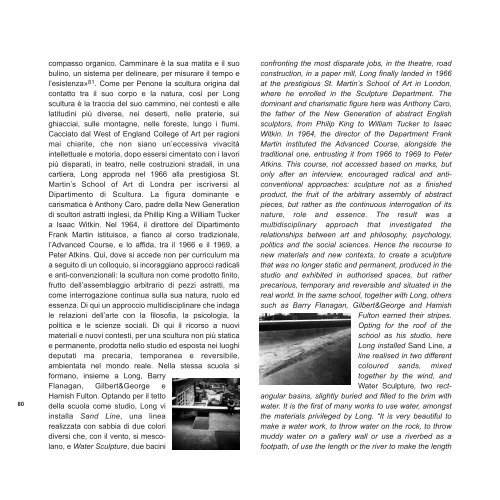Adachiara Zevi - arteinmemoria
Adachiara Zevi - arteinmemoria
Adachiara Zevi - arteinmemoria
You also want an ePaper? Increase the reach of your titles
YUMPU automatically turns print PDFs into web optimized ePapers that Google loves.
80<br />
compasso organico. Camminare è la sua matita e il suo<br />
bulino, un sistema per delineare, per misurare il tempo e<br />
l’esistenza» 81 . Come per Penone la scultura origina dal<br />
contatto tra il suo corpo e la natura, così per Long<br />
scultura è la traccia del suo cammino, nei contesti e alle<br />
latitudini più diverse, nei deserti, nelle praterie, sui<br />
ghiacciai, sulle montagne, nelle foreste, lungo i fiumi.<br />
Cacciato dal West of England College of Art per ragioni<br />
mai chiarite, che non siano un’eccessiva vivacità<br />
intellettuale e motoria, dopo essersi cimentato con i lavori<br />
più disparati, in teatro, nelle costruzioni stradali, in una<br />
cartiera, Long approda nel 1966 alla prestigiosa St.<br />
Martin’s School of Art di Londra per iscriversi al<br />
Dipartimento di Scultura. La figura dominante e<br />
carismatica è Anthony Caro, padre della New Generation<br />
di scultori astratti inglesi, da Phillip King a William Tucker<br />
a Isaac Witkin. Nel 1964, il direttore del Dipartimento<br />
Frank Martin istituisce, a fianco al corso tradizionale,<br />
l’Advanced Course, e lo affida, tra il 1966 e il 1969, a<br />
Peter Atkins. Qui, dove si accede non per curriculum ma<br />
a seguito di un colloquio, si incoraggiano approcci radicali<br />
e anti-convenzionali: la scultura non come prodotto finito,<br />
frutto dell’assemblaggio arbitrario di pezzi astratti, ma<br />
come interrogazione continua sulla sua natura, ruolo ed<br />
essenza. Di qui un approccio multidisciplinare che indaga<br />
le relazioni dell’arte con la filosofia, la psicologia, la<br />
politica e le scienze sociali. Di qui il ricorso a nuovi<br />
materiali e nuovi contesti, per una scultura non più statica<br />
e permanente, prodotta nello studio ed esposta nei luoghi<br />
deputati ma precaria, temporanea e reversibile,<br />
ambientata nel mondo reale. Nella stessa scuola si<br />
formano, insieme a Long, Barry<br />
Flanagan, Gilbert&George e<br />
Hamish Fulton. Optando per il tetto<br />
della scuola come studio, Long vi<br />
installa Sand Line, una linea<br />
realizzata con sabbia di due colori<br />
diversi che, con il vento, si mescolano,<br />
e Water Sculpture, due bacini<br />
confronting the most disparate jobs, in the theatre, road<br />
construction, in a paper mill, Long finally landed in 1966<br />
at the prestigious St. Martin’s School of Art in London,<br />
where he enrolled in the Sculpture Department. The<br />
dominant and charismatic figure here was Anthony Caro,<br />
the father of the New Generation of abstract English<br />
sculptors, from Philip King to William Tucker to Isaac<br />
Witkin. In 1964, the director of the Department Frank<br />
Martin instituted the Advanced Course, alongside the<br />
traditional one, entrusting it from 1966 to 1969 to Peter<br />
Atkins. This course, not accessed based on marks, but<br />
only after an interview, encouraged radical and anticonventional<br />
approaches: sculpture not as a finished<br />
product, the fruit of the arbitrary assembly of abstract<br />
pieces, but rather as the continuous interrogation of its<br />
nature, role and essence. The result was a<br />
multidisciplinary approach that investigated the<br />
relationships between art and philosophy, psychology,<br />
politics and the social sciences. Hence the recourse to<br />
new materials and new contexts, to create a sculpture<br />
that was no longer static and permanent, produced in the<br />
studio and exhibited in authorised spaces, but rather<br />
precarious, temporary and reversible and situated in the<br />
real world. In the same school, together with Long, others<br />
such as Barry Flanagan, Gilbert&George and Hamish<br />
Fulton earned their stripes.<br />
Opting for the roof of the<br />
school as his studio, here<br />
Long installed Sand Line, a<br />
line realised in two different<br />
coloured sands, mixed<br />
together by the wind, and<br />
Water Sculpture, two rectangular<br />
basins, slightly buried and filled to the brim with<br />
water. It is the first of many works to use water, amongst<br />
the materials privileged by Long. “It is very beautiful to<br />
make a water work, to throw water on the rock, to throw<br />
muddy water on a gallery wall or use a riverbed as a<br />
footpath, of use the length or the river to make the length


